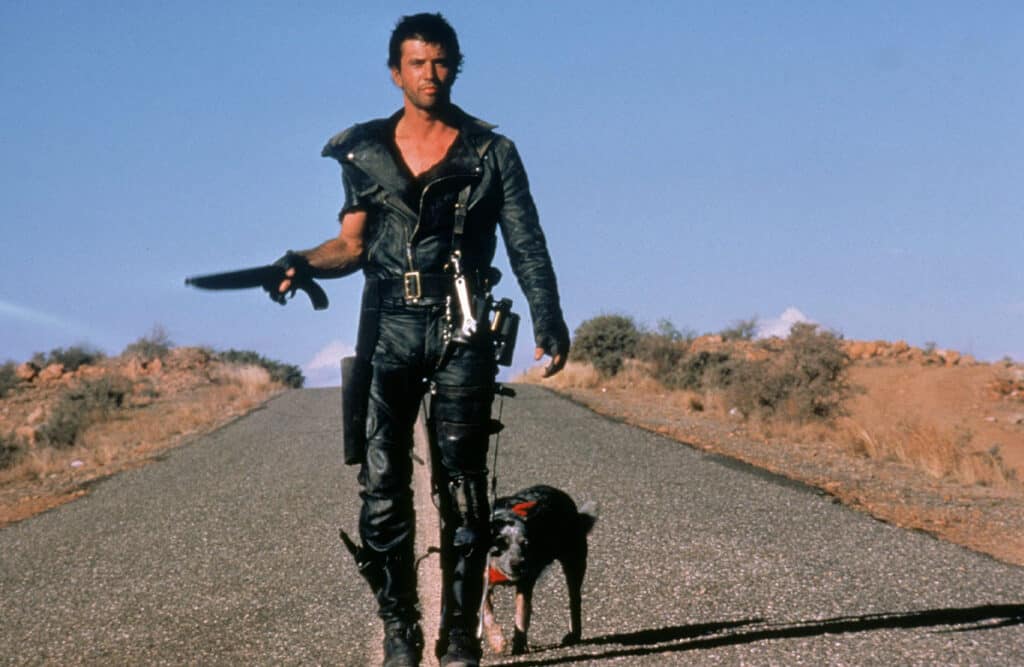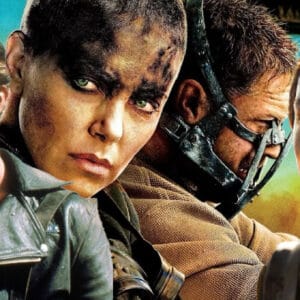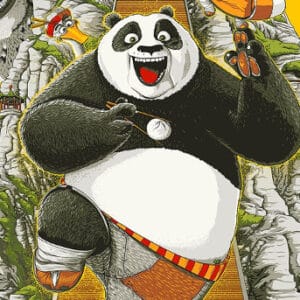Last Updated on July 31, 2024
Quick: what’s the all-time best middle movie in a popular OG cinematic trilogy? Yes, The Godfather Part II and The Empire Strikes Back are obvious and beyond reproach, but what else comes to mind? Aliens? Terminator 2? Back to the Future Part 2? Evil Dead 2? What about Oldboy or Indiana Jones and the Temple of Doom? Yeah, all worthy responses that happened to be flat-out wrong!
When peering through the rear-view at the best movie trilogy centerpiece, Mad Max 2: The Road Warrior leaves the others in the dust. Released two years after the handcrafted, low-budget original Mad Max, the making of The Road Warrior couldn’t have been more different than what visionary filmmaker George Miller experienced on the first go-around. For instance, the first film was hampered by limited resources and budgetary restrictions. Meanwhile, the sequel was strapped with over 10 times the original movie’s budget, allowing Miller to execute the dazzling, death-defying set pieces and action sequences that eluded him in the first film.
Yet, despite the financial leeway that gave Miller creative freedom, the maxing of The Road Warrior was anything but a smoothly paved escapade. In detailing the production history of Mad Max 2, we’ll learn what inspired the film, how it was developed, how long it took to make, the problems Miller encountered, on-set injuries and accidents, cool trivial anecdotes, and more. After all, we’re not just here for the gasoline, we’re about to find out What Happened to The Road Warrior ahead!
Following the massive success of Mad Max in 1979 and 1980, writer/director George Miller was flooded with a slew of Hollywood movie offers. Most fans don’t know that Miller was offered to direct First Blood. Miller turned down the chance to helm the first Rambo movie to make a rock-n-roll-themed musical instead. The rock project was titled Roxanne, possibly after the hit 1978 Police track of the same name. Miller reunited with writer Terry Hayes after collaborating on the novelization of Mad Max and began working on Roxanne. The script for the rock-n-roll movie was put on the back burner, and Miller and Hayes redirected their focus on a Mad Max sequel. Miller felt that making a sequel with more money would allow him to achieve what he couldn’t the first time around, telling The New York Times:
“Making Mad Max was a very unhappy experience for me. I had absolutely no control over the final product. There was strong pressure to make a sequel, and I felt we could do a better job with a second movie.”
While the original Mad Max was partially inspired by silent Buster Keaton and Harold Lloyd movies, The Road Warrior was influenced by the work of Akira Kurosawa, Carl Jung, and Joseph Campbell’s The Hero with a Thousand Faces. Like the original, Miller cited the 1975 Australian film A Boy and His Dog as a major influence on The Road Warrior. He also attributed the hyper-violence of A Clockwork Orange as inspiration. The story also parallels the classic American western Shane, as seen through Max’s relationship with Feral Boy. Miller, Hayes, and co-writer Brian Hannant fleshed out the screenplay, with Hannant also working as first AD and second unit director.
Although the budget for Mad Max ranged between $300,000 to $400,000, The Road Warrior was loaded with a $4.5 million budget, more than tenfold what Miller had to work with on the original. As such, The Road Warrior was the most expensive Australian movie production when it was made in the winter of 1981. While such an investment was seen as risky, the movie would go on to gross roughly three times as much as the first film. Even more impressive, Miller claims The Road Warrior was written and released within one calendar year, a much shorter journey than the long and winding Fury Road, which took 12 years from script to exhibition.

Backed by a $4.5 million budget, the post-apocalyptic neo-western took 12 weeks to complete principal photography, the same amount of time as the original. Despite the hot, sweaty appearance of the sun-scorched Aussie outback, The Road Warrior was filmed during the winter of 1981 and was extremely cold. For instance, Mel Gibson would sprint off-screen and bundle up beneath blankets as soon as his scenes were filmed despite wearing leather costumes. The bikers wearing ass-less leather chaps also suffered from the extreme cold. It got so bad that Gibson nicknamed Veron Wells, who plays the mohawked marauder Wez, Barometer Bum due to his ass constantly turning purple while filming in the frigid conditions. The film location was also chosen based on weather forecasts, which predicted very little rainfall. However, the production had to be shut down for one week when it began raining for the first time in four years.
Speaking of filming, The Road Warrior was shot entirely in sequence – a rarity for an action movie – and filmed in Broken Hill, near New South Wales, Australia. Miller hired Dean Semler as the Director of Photography, and the DP would return to the area to film the landmark Australian creature feature Razorback in 1984. Of course, one of the first things that stands out in The Road Warrior is Max Rockatansky’s relationship with his Australian Cattle Dog. Despite giving an unforgettable performance, the Dog was found at a nearby pound one day before he was scheduled to be put to sleep. The Dog was chosen among several lookalikes after picking up a rock and laying it down like a toy. Afterward, the dog was quickly trained to perform in the movie and was later adopted by a camera operator after filming wrapped. The Dog was also fitted with ear plugs to avoid the loud car engines while performing after soiling a car due to the loud disturbances. The Dog also got along quite well with actor Bruce Spence, who plays perverted comic relief Gyro Captain, despite antagonizing each other’s characters in the film.
One of the first big events in the movie involves Max overpowering the Gyro Captain and driving to the oil refinery in the desert. Thanks to the massive budget, the oil refinery set marked the most expensive set built for an Australian movie. The detonation of the refinery later in the film marked the biggest explosion in the history of Australian cinema at the time it was recorded. Under the supervision of the Australian army, the blast was so gigantic that airlines were notified beforehand. Huge shockwaves radiated throughout the desert on impact.
At the refinery, Max spots Lord Humungus in a metallic hockey mask. Lord Humungus was originally meant to be Jim Goose, Max’s partner from the first film. Although this was changed, a few subtle clues indicate the linkage. For instance, Humungus has a burned scalp behind his hockey mask, his roving band of marauders drive police cars, and he sports a similar MFP handgun used by Goose in the original film. Two characters in the script were also given gender reversals, including Wez’s loverboy Golden Youth, and Max’s brief companion settler Warrior Woman. The Golden Youth was originally written to be a woman and Warrior Woman a man, with the interchangeable genders underscoring how there’s no difference between the masculine and feminine in Mad Max’s punishing Wasteland. This thematic motif has been advanced in Fury Road and Furiosa.
Speaking of appearances, the grungy leather-clad costumes worn by most of the marauders were inspired by S&M attire. Much of the clothing was found at local thrift shops, junk stores, sporting outlets, garage sales, etc. As for Max’s rough-hewn appearance, it was Gibson’s idea. He grew stubble, cut his hair and eyebrows, ripped his leather jacket sleeve, and tore his gloves apart before filming to give Max a more rugged and uncivilized look. Gibson only speaks 16 lines of dialog in the entire film, including the repeated mission statement, “I’m only here for the gasoline.” Gibson never smiles either, only expresses a few “Mona Lisa grins” according to Miller.
For those wondering, Max’s V8 Interceptor Pursuit Special is the same car Gibson drove in the original film. After Mad Max wrapped production, the vehicles used were set to be destroyed. The lone survivor was the original V8 Interceptor Pursuit Special, deemed too iconic to junk. Once The Road Warrior was announced, the Interceptor was tracked down and recycled for the sequel. For the scene in Mundi Mundi where the Interceptor rolls and catches fire, photography occurred outside Silverton on Wilangee Road.
The original Pursuit Special – a 1973 Ford XB Falcon GT 351 – was modified and reused in the sequel for interior close-ups of Max driving inside the vehicle. A second Interceptor model was utilized for the chase sequences in The Road Warrior and was deliberately destroyed when the script called for it to launch off the road and explode. The OG Interceptor from the first film can be seen in the Cars for the Stars Motor Museum in England.
Much like the original, The Road Warrior holds up thanks to the incredible practical FX and genuine death-defying stuntwork. One of the most notorious mishaps while making the movie occurred when filming the scene where a motorcycling marauder flies off the bike during the final tanker chase scene, smashes his legs into a car, and somersaults in the air toward the camera. The sequence was originally planned for the biker to fly over the car without making contact. However, stunt performer Guy Norris nearly lost his life when he crashed into the vehicle and shattered his femur bone on impact. Despite Norris breaking his leg and almost losing his life on camera, Miller kept the shot of the accident in the final film for its dramatic effect.

With real cars, real crashes, real explosions, and no CGI or phony digital augmentation, The Road Warrior still kicks ass in 2024 due to its unwavering authenticity (we recently named it one of the greatest action movies ever made, as well as our favorite in the Mad Max series). In addition to genuinely detonating the refinery compound under military supervision, one of the biggest challenges was rolling the giant oil tanker at the end of the movie. The scene was considered so potentially harmful that the stunt driver was ordered not to eat any food 12 hours before the stunt was performed in case he needed to be rushed into medical surgery.
On July 24, 1981, scenes filmed included Papagallo’s death, Wez’s final attempt to kill Feral Boy, and the oil tanker colliding with Humungus’ car. The busy schedule was also slated to accommodate the tanker’s rollover the same day was postponed for the following day. The point is, that despite having 10 times the original budget, The Road Warrior was made as fast and furiously as its predecessor and still one-ups the gritty intensity.
Meanwhile, Miller was so gung-ho about capturing visceral footage that he was dressed in costume, placed in a buggy, and controlled the car-mounted camera rig from inside by turning it on and off as needed. Yet, Miller flubbed the timing, hit the wrong buttons on the first take, and was immediately replaced with a camera operator. Miller and Semler also utilized remote-control cameras placed inside reinforced steel housings called Ned Kellys, named for the impenetrable armor worn by the notorious Aussie outlaw of the same name.
With more than 200 stunts in the film, over 80 custom vehicles were utilized during the production and roughly half were demolished by the end of filming. Hilariously enough, while filming the suspenseful chase finale, a mail carrier interrupted the shot after casually sauntering onto a closed portion of the road. Unaffected by the movie shoot, the mailman drove through the blockade declaring, “The mail must go through.”
As for the lack of green screen technology, the shot of Max’s body lying out of the Gyrocopter with the ground below was filmed practically without CGI. According to Semler, Gibson was instructed to lie flat on a plank attached and extended out the chopper door. Semler adds that if the shot were filmed today, it would be done digitally like most of Fury Road and Furiosa.
One cool trick Miller and Semler used to simulate high-speed road racing involves basic camera framing. According to Semler, medium shots of Max inside the car with zero movement behind him were filmed while the vehicles were stationary. Anytime viewers can see movement in the background as cars drive, they’re in motion for real. As Semler says: “If you can see the road moving behind, we’re moving. If you don’t see anything moving behind, we’re not moving.”
For the oil tanker chases, Gibson had to be replaced with a stunt driver because he didn’t know how to operate the manual quad-box transmission. The stunt driver would speed the tanker up, duck out of the camera’s view, and allow Gibson to take his place and film his close-ups. To increase car chase velocity, Miller would drop frames in certain scenes, including Max’s departure from the compound early in the film.
There are several other cool trivial tidbits about the making of The Road Warrior. For instance, the two captives strapped to the hood of Humungus’ car are dummies, or as Semler calls them, “Watermelons with wigs.” Meanwhile, the motorcycle wheelie stunt in the film was not performed with a dummy as long been rumored. Instead, it was performed by a local Broken Hill resident and his girlfriend. As for the backflip performed by Feral Boy, it was not done by actor Emil Minty. Instead, the backflip was executed by a local female gymnast named Melissa. Minty, who beat out hundreds of kids to play Feral Boy, was instructed by Miller to create the character’s backstory. Minty also had a terrible flu while filming and nearly contracted pneumonia. Despite providing comic relief, Bruce Spence was also unwell during production and was released from the hospital days before filming his part.
Speaking of Feral Boy, who is revealed to narrate the movie at the end, a long-circulating theory once suggested that he grows up to become the Max in Fury Road. However, Miller refuted this rumor in a comic he penned for Vertigo in 2015, confirming that Mel Gibson and Tom Hardy’s Max Rockatansky are the same person. Yet, while Feral Boy has little to do with Mad Max 4, his backstory did inspire the third instalment, Mad Max: Beyond Thunderdome. At first, Max’s story was planned to end with The Road Warrior. However, Miller was so inspired by Feral Boy’s storyline that he sought to make a Lord of the Flies-style movie focusing on lawless children in the wild. Once Miller got the idea to have Max chaperone the children and guide them toward salvation, the inspiration for Beyond Thunderdome was born.
But before veering off into the Mad Max sequels, it’s worth noting that the original cut of The Road Warrior was much gorier and more violent than the final version. One of the differences involves the oil tanker finale. In the original script, Wez was meant to leap atop the tanker after his men attack it and roll it off the road. As the marauders realize that the tanker is full of sand instead of gas, they cry, “Where’s the fuel?” Wez responds, “I know where’s fuel,” and lethally shoots Humungus with his crossbow and peels out across the sand.
Several other hyperviolent scenes were cut from the film, or deleted entirely, to secure an M-rating from Australian censors. Two scenes involving Wez had to be edited. The first was a shot of him removing an arrow from his forearm. The second was the shot of Wez removing the boomerang from the Golden Youth’s head.
Yet, despite toning down the graphic violence and reducing the bloodshed, The Road Warrior still reigns supreme as the best Mad Max movie on record. Not only in the eyes of fans, but Miller and Gibson have publicly stated that The Road Warrior is both of their favorite Mad Max movie. The film was a critical and commercial success, grossing over $36 million worldwide when factoring in box office and rental sales. The Road Warrior was unanimously hailed as one of the finest films released in 1981, launching Miller’s career into an international stratosphere. Steven Spielberg loved The Road Warrior so much that he hired Miller to direct the best segment of Twilight Zone: The Movie, “Nightmare at 30,000 Feet.” Co-director Joe Dante, who helmed segment three, “It’s a Good Life,” famously approached Miller after seeing The Road Warrior and told him he knew how quickly the movie was because of how the sun shifts positions between sunrise and sunset in any given shot. Dante told Miller, “You certainly can’t wait for your light,” and Miller responded with, “You just have to keep on shooting.”
James Cameron has also stated his affinity for The Road Warrior and has cited the movie’s inspiration for the Terminator and T-2: Judgment Day. Furthermore, the character of Newt in Cameron’s Aliens also resembles Feral Boy both physically and narratively. Beyond the movie’s famous influences, The Road Warrior has withstood the test of time long enough to pave the way for three more franchise sequels, with the latest, Furiosa, now on VOD. Until then, this is a good spot to hit the brakes, stop and say, that’s What Happened to Mad Max 2: The Road Warrior!



















Follow the JOBLO MOVIE NETWORK
Follow us on YOUTUBE
Follow ARROW IN THE HEAD
Follow AITH on YOUTUBE